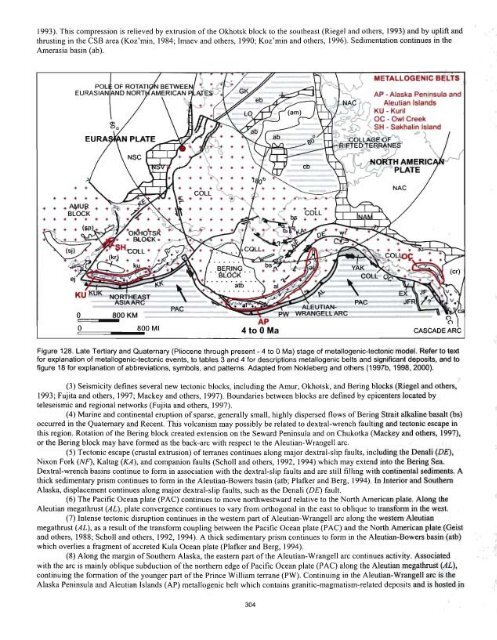Metallogenesis and Tectonics of the Russian Far East, Alaska, and ...
Metallogenesis and Tectonics of the Russian Far East, Alaska, and ...
Metallogenesis and Tectonics of the Russian Far East, Alaska, and ...
Create successful ePaper yourself
Turn your PDF publications into a flip-book with our unique Google optimized e-Paper software.
1993). This compression is relieved by extrusion <strong>of</strong> <strong>the</strong> Okhotsk block to <strong>the</strong> sou<strong>the</strong>ast (Riegel <strong>and</strong> o<strong>the</strong>rs, 1993) <strong>and</strong> by uplift <strong>and</strong><br />
thrusting in <strong>the</strong> CSB area (Koz'min, 1984; Imaev <strong>and</strong> o<strong>the</strong>rs, 1990; Koz'min <strong>and</strong> o<strong>the</strong>rs, 1996). Sedimentation continues in <strong>the</strong><br />
Amerasia basin (ab).<br />
. + t *<br />
+ * + + *<br />
+ + * + + + +<br />
4 + + + + * * + + +<br />
+ * + + +<br />
+ ......<br />
COLLAGE OF<br />
RIFTED TERRANES<br />
AP -<strong>Alaska</strong> Pen~nsula <strong>and</strong><br />
Aleut~an Isl<strong>and</strong>s<br />
OC - Owl Creek<br />
SH - Sakhal~n Isl<strong>and</strong><br />
Figure 128. Late Tertiary <strong>and</strong> Quaternary (Pliocene through present - 4 to 0 Ma) stage <strong>of</strong> metallogenic-tectonic model. Refer to text<br />
for explanation <strong>of</strong> metallogenic-tectonic events, to tables 3 <strong>and</strong> 4 for descriptions metallogenic belts <strong>and</strong> significant deposits, <strong>and</strong> to<br />
figure 18 for explanation <strong>of</strong> abbreviations, symbols, <strong>and</strong> patterns. Adapted from Nokleberg <strong>and</strong> o<strong>the</strong>rs (1997b, 1998, 2000).<br />
(3) Seismicity defines several new tectonic blocks, including <strong>the</strong> b ur, Okhotsk, <strong>and</strong> Bering blocks (Riegel <strong>and</strong> o<strong>the</strong>rs,<br />
1993; Fujita <strong>and</strong> o<strong>the</strong>rs, 1997; Mackey <strong>and</strong> o<strong>the</strong>rs, 1997). Boundaries between blocks are defined by epicenters located by<br />
teleseismic <strong>and</strong> regional networks (Fujita <strong>and</strong> o<strong>the</strong>rs, 1997).<br />
(4) Marine <strong>and</strong> continental eruption <strong>of</strong> sparse, generally small, highly dispersed flows <strong>of</strong> Bering Strait alkaline basalt (bs)<br />
occurred in <strong>the</strong> Quaternary <strong>and</strong> Recent. This volcanism may possibly be related to dextral-wrench faulting <strong>and</strong> tectonic escape in<br />
this region. Rotation <strong>of</strong> <strong>the</strong> Bering block created extension on <strong>the</strong> Seward Peninsula <strong>and</strong> on Chukotka (Mackey <strong>and</strong> o<strong>the</strong>rs, 1997),<br />
or <strong>the</strong> Bering block may have formed as <strong>the</strong> back-arc with respect to <strong>the</strong> Aleutian-Wrangell arc.<br />
(5) Tectonic escape (crustal extrusion) <strong>of</strong> terranes continues along major dextral-slip faults, including <strong>the</strong> Denali (DE),<br />
Nixon Fork (NF), Kaltag (KA), <strong>and</strong> companion faults (Scholl <strong>and</strong> o<strong>the</strong>rs, 1992, 1994) which may extend into <strong>the</strong> Bering Sea.<br />
Dextral-wrench basins continue to form in association with <strong>the</strong> dextral-slip faults <strong>and</strong> are still filling with continental sediments. A<br />
thick sedimentary prism continues to form in <strong>the</strong> Aleutian-Bowers basin (atb; Plafker <strong>and</strong> Berg, 1994). In Interior <strong>and</strong> Sou<strong>the</strong>rn<br />
<strong>Alaska</strong>, displacement continues along major dextral-slip faults, such as <strong>the</strong> Denali (DE) fault.<br />
(6) The Pacific Ocean plate (PAC) continues to move northwestward relative to <strong>the</strong> North American plate. Along <strong>the</strong><br />
Aleutian megathrust (AL), plate convergence continues to vary from orthogonal in <strong>the</strong> east to oblique to transform in <strong>the</strong> west.<br />
(7) lntense tectonic disruption continues in <strong>the</strong> western part <strong>of</strong> Aleutian-Wrangell arc along <strong>the</strong> western Aleutian<br />
megathrust (AL), as a result <strong>of</strong> <strong>the</strong> transform coupling between <strong>the</strong> Pacific Ocean plate (PAC) <strong>and</strong> <strong>the</strong> North American plate (Geist<br />
<strong>and</strong> o<strong>the</strong>rs, 1988; Scholl <strong>and</strong> o<strong>the</strong>rs, 1992, 1994). A thick sedimentary prism continues to form in <strong>the</strong> Aleutian-Bowers basin (atb)<br />
which overlies a fragment <strong>of</strong> accreted Kula Ocean plate (Plafker <strong>and</strong> Berg, 1994).<br />
(8) Along <strong>the</strong> margin <strong>of</strong> Sou<strong>the</strong>rn <strong>Alaska</strong>, <strong>the</strong> eastern part <strong>of</strong> <strong>the</strong> Aleutian-Wrangell arc continues activity. Associated<br />
with <strong>the</strong> arc is mainly oblique subduction <strong>of</strong> <strong>the</strong> nor<strong>the</strong>rn edge <strong>of</strong> Pacific Ocean plate (PAC) along <strong>the</strong> Aleutian megathrust (AL),<br />
continuing <strong>the</strong> formation <strong>of</strong> <strong>the</strong> younger part <strong>of</strong> <strong>the</strong> Prince William terrane (PW). Continuing in <strong>the</strong> Aleutian-Wrangell arc is <strong>the</strong><br />
<strong>Alaska</strong> Peninsula <strong>and</strong> Aleutian lsl<strong>and</strong>s (AP) metallogenic belt which contains granitic-magmatism-related deposits <strong>and</strong> is hosted in
















